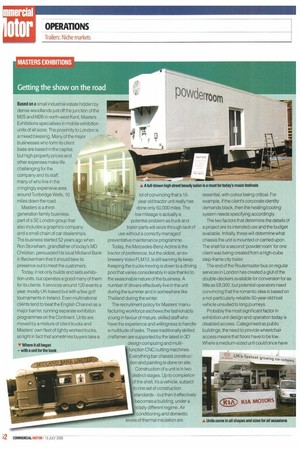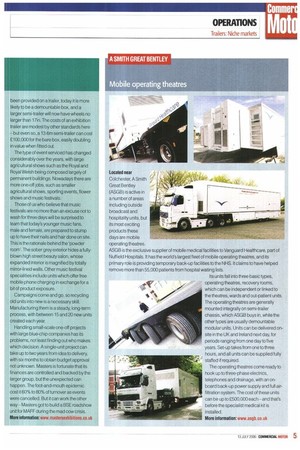MASTERS EXHIBITIONS
Page 52

Page 53

If you've noticed an error in this article please click here to report it so we can fix it.
Getting the show on the road
Based on a small industrial estate hidden by dense woodlands just off the junction of the M25 and M26 in north-west Kent, Masters Exhibitions specialises in mobile exhibition units of all sizes. The proximity to London is a rnixed blessing. Many of the major businesses who form its client base are based in the capital, but high property prices and other expenses make life challenging for the company and its staff, many of who live in the cringingly expensive area around Tunbridge Weds, 10 miles down the road.
Masters is a thirdgeneration family business, part of a SE London group that also includes a graphics company and a small chain of car dealerships. The business started 52 years ago when Ron Stoneham, grandfather of today's MD Christian, persuaded his local Midland Bank in Beckenham that it should take its presence out to meet the customers.
Today, it not only builds and sells exhibition units, but operates a good many of them for Its clients. It services around 120 events a year, mostly UK-based but with a few golf tournaments in Ireland. Even multinational clients tend to treat the English Channel as a major barrier, running separate exhibition programmes on the Continent. Units are moved by a mixture of client trucks and Masters own fleet of lightly worked trucks, so light in fact that sometimes buyers take a
lot of convincing that a 15year old tractor unit really has done only 50,000 miles. The low mileage is actually a potential problem as truck and trailer parts will seize through lack of use without a correctly managed preventative maintenance programme.
Today, the Mercedes-Benz Actros is the tractor of preference, but the oldest, an exbrewery Volvo FLM12, is still earning its keep. Keeping the trucks moving is down to a driving pool that varies considerably in size thanks to the seasonable nature of the business. A number of drivers effectively live in the unit during the summer and in somewhere like Thailand during the winter.
The recruitment policy for Masters' manufacturing workforce eschews the fashionably young in favour of mature, skilled staff who have the experience and willingness to handle a multitude of tasks. These traditionally skilled craftsmen are supported by the latest in 3D design computing and multi function CNC cutting machines. Everything bar chassis construction and painting is done on site. Construction of a unit is in two istinct stages. Up to completion f the shell, it's a vehicle, subject o one set of construction standardsbut then it effectively becomes a building, under a totally different regime. Air conditioning and domestic levels of thermal insulation are essential, with colour being critical. For example, if the client's corporate identity demands black, then the heating/cooling system needs specifying accordingly.
The two factors that determine the details of a project are its intended use and the budget available. Initially, these will determine what chassis the unit is mounted or carried upon. The shell for a second 'powder room' for one client was being created from a high-cube step-frame city trailer.
The end of the Routemaster bus on regular services in London has created a glut of the double-deckers available for conversion for as little as C8,000, but potential operators need convincing that the romantic idea is based on a not-particularly-reliable 50-year-old host vehicle unsuited to long journeys.
Probably the most significant factor in exhibition unit design and operation today is disabled access. Categorised as public buildings, the need to provide wheelchair access means that floors have to be low. Where a medium-sized unit could once have
been provided on a trailer, today it is more likely to be a demountable box, and a larger semi-trailer will now have wheels no larger than 17in. The costs of an exhibition trailer are modest by other standards here but even so, a 13,6m semi-trailer can cost £100,000 for the bare box, easily doubling in value when fitted out.
The type of event serviced has changed considerably over the years, with large agricultural shows such as the Royal and Royal Welsh being composed largely of permanent buildings. Nowadays there are more one-off jobs, such as smaller agricultural shows, sporting events, flower shows and music festivals.
Those of us who believe that music festivals are no more than an excuse not to wash for three days will be surprised to learn that today's younger music fans, male and female, are prepared to stump up to have their nails and hair done on site. This is the rationale behind the 'powder room'. The sober grey exterior hides a fully blown high street beauty salon, whose expanded interior is magnified by totally mirror-lined walls. Other music festival specialities include units which offer free mobile phone charging in exchange for a bit of product exposure.
Campaigns come and go, so recycling old units into new is a necessary skill. Manufacturing them is a steady, long-term process, with between 15 and 20 new units created each year.
Handling small-scale one-off projects with large blue-chip companies has its problems, not least finding out who makes which decision. A single-unit project can take up to two years from idea to delivery, with six months to obtain budget approval not unknown. Masters is fortunate that its finances are controlled and backed by the larger group. but the unexpected can happen. The foot-and-mouth epidemic cost it 60% to 80% of turnover as events were cancelled. But it can work the other way -Masters got to build a BSE roadshow unit for MAFF during the mad cow crisis. More information: www. masteisexhibitions.co.uk
































































































































































































